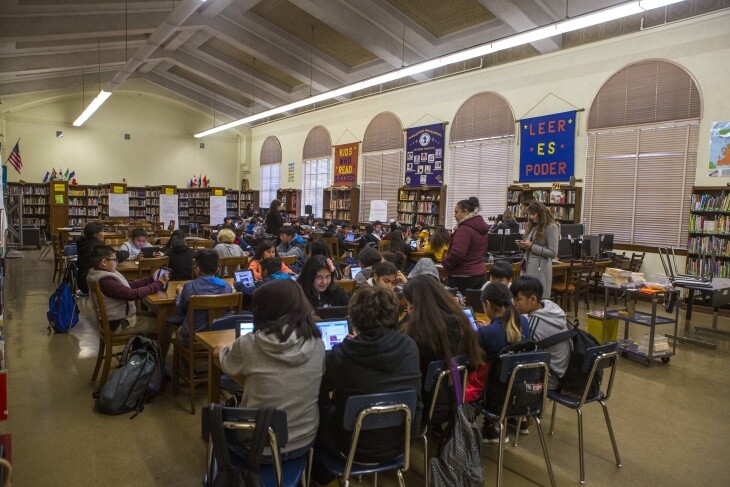Truth matters. Community matters. Your support makes both possible. LAist is one of the few places where news remains independent and free from political and corporate influence. Stand up for truth and for LAist. Make your year-end tax-deductible gift now.
SoCal's Latino Kids Are Going To School With Fewer And Fewer White Kids

Latino students in California public schools are more racially isolated from their white peers than in any other state -- academics have known this for years. And a new study released Tuesday shows the problem is not getting better.
In fact, the study, which focused on Latino students in the nation's elementary schools, found racial segregation is "intensifying" for these children, both in Southern California and nationwide.
Nationwide measures of racial isolation show Latino students were more isolated from white peers in 2015 than they were just five years earlier, largely driven by population growth in already segregated enclaves in urban school districts like Los Angeles Unified or Long Beach Unified.
The worsening trend holds true in Southern California, too -- and not just in urban schools. Data from the study's authors show that in 145 out of 150 school districts across the region, Latino students likely had fewer white classmates than they did two decades ago.

This matters, the study's authors write, because "racially segregating students of color ... often corresponds with unfair financing of schools, regressive allocation of quality teachers and culturally limited curricula."
But there may be a silver lining: the authors found low-income students -- regardless of race -- are more likely to share classrooms with middle-class children than they were in 1998, even if rates of racial segregation aren't improving.
"An expanding Latino middle class is moving to economically better-off neighborhoods and schools that are more integrated, at least along social-class lines," the study's authors conclude.

The research team -- from UC Berkeley, UC Irvine and the University of Maryland -- highlighted the L.A. area as typifying these twin trends of worsening racial segregation and increased socio-economic mixing.
In districts like Santa Ana, Montebello, Compton or Inglewood, the average Latino elementary student is likely to have only one white peer out of every 100 classmates. A Latino child in Oxnard's elementary schools is likely to have only three white classmates out of every 100.
On the other hand, the study's authors see a connection between rising economic integration and the nationwide trend of Latino families moving to the suburbs.
Study lead author Bruce Fuller points to enclaves in the suburban San Gabriel Valley, where white and Latino residents are increasingly living alongside one another -- with some evidence that low- and middle-income students are mixing in the same schools, too.
"There are many, many young Latino families who ... are becoming more and more educated," Fuller said in an interview, "and that allows for movement into more economically-integrated communities. Now [these communities] might still be predominantly Latino, but at least we're achieving economic integration for many, many Latino kids."
Fuller takes a glass-half-full view of this particular trend -- the study's authors say it might be evidence that some Latino immigrants are succeeding in assimilating into the middle class.
"If we can get poor kids in the same classrooms as middle-class kids," Fuller said, "we're probably going to see stronger educational outcomes."
But the study's authors acknowledge that in the "aging suburbs and exurbs" to which some Latinos are migrating, some educators are culturally "ill-prepared" for their arrival -- and some incumbent residents are "downright hostile."

And there's still another problem with the study's optimistic view, notes UCLA professor Gary Orfield: while it's possible that Latinos are integrating the suburbs, it's also possible that suburbs are simply transitioning from racially isolated white areas to racially isolated enclaves for minorities.
So which is more likely? "The way I look at it," said Orfield, who is co-director of UCLA's Civil Rights Project, "is that it depends on what we do about it -- and if we do nothing about it, the dominant pattern is resegregation."
Fuller said nothing in his team's study contradicts the notion that black or Latino students are increasingly racially isolated.
"I think it's important to remind the nation that we are resegregating," Fuller said. "We've reversed our progress since the 1970s, both for blacks and Latinos. Our findings this week are consistent with that."
Fuller also said his study aimed to add nuance to the discussion of socio-economic integration in schools -- particularly as demographics shift in the suburbs.
The big-picture racial segregation number is often a "very dramatic indicator," Fuller said. "But it doesn't illuminate these shades of gray."
-- NORMAL --
-- NORMAL --







